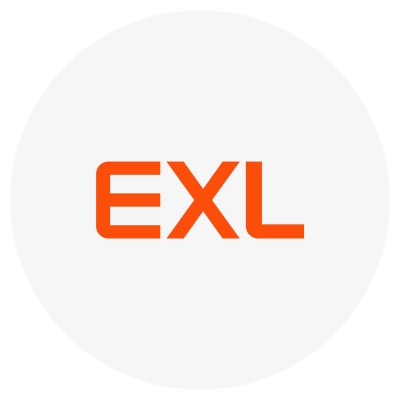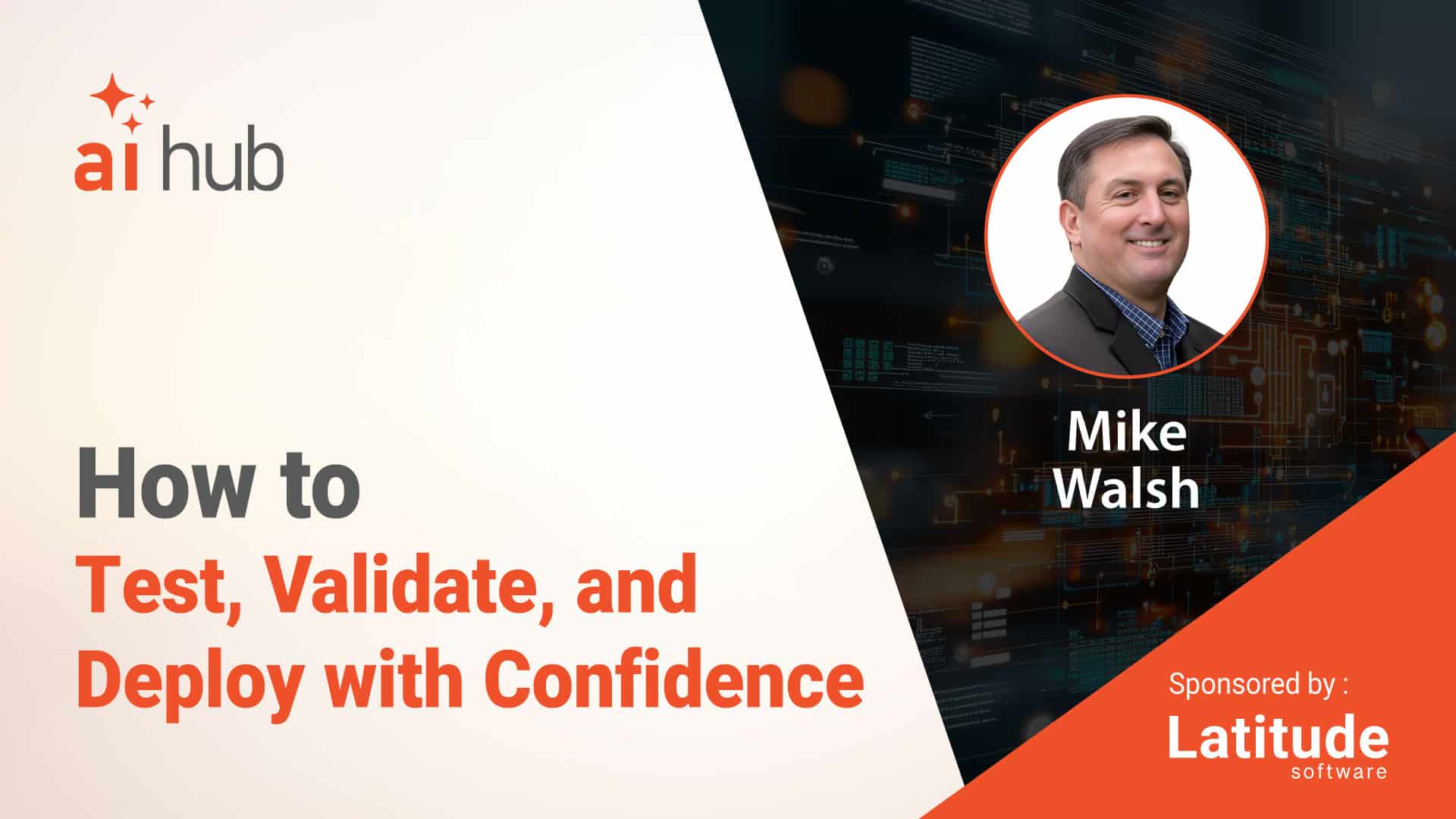Discover how AI in debt collection is revolutionizing the receivables industry. In this AI Hub episode, Mike Walsh from EXL shares how intelligent virtual agents and AI compliance solutions are reshaping consumer engagement and risk mitigation strategies.
Adam Parks (00:06)
Hello everybody, Adam Parks here with an episode of the AI Hub. And today I’m here with one of my good friends and someone who is in the trenches helping organizations to actually deploy artificial intelligence in the debt collection space. I’ve got Mike Walsh here with me from EXL. But before we jump into that, just a quick word from our sponsor, Latitude by Genesis.
All right, Mike, really excited to have you here today. Thank you so much for coming on and having a chat with me. I really do appreciate your insights because I know that you are deep in it right now making it happen.
Mike Walsh (01:35)
Sure.
Took some training today, buddy. So yes, we are. EXL is a massive company traded on NASDAQ. have a product called Paymentor that does intelligent email, two-way SMS that has a conversational AI piece in it, as well as connected to a voice, virtual agent, everybody calls it virtual assistant, intelligent IVR, whatever you want to call it, as well as
Adam Parks (01:42)
Hahaha
Mike Walsh (02:05)
some smart agent which can coach your agent in real time. And then we have some audit tools that will help you QR the whole collection process if you’re a creditor with your agencies or a debt buyer with your agencies or just your agents. So we’re all over this space and we’re in other spaces as well, Adam, but it’s the future. It’s changing quickly.
and it’s simpler to onboard than you think.
Adam Parks (02:36)
And that’s why I wanted to have you on today.
Because we’ve saw in the 2024 debt collection industry report that there is a significant increase in the use of artificial intelligence. And some use cases are lagging behind others in terms of adoption, voice being the one that’s
dragging the furthest behind, but something that I know that you had a lot of experience in. So let me start with a kind of high level question here and say, okay, so I’m a debt collection operation, I’m a debt collection professional who wants to start using artificial intelligence to improve the efficiencies of my organization and to improve the quality of the service I provide to the consumer. What does the first step look like in a journey of a thousand miles?
Mike Walsh (03:17)
I think the first step is harder to realize, but simpler than you think. It’s what outcome am I trying to accomplish, right? So if you’re going to use AI to talk to customers, that’s a big one, right? Or if you’re going to use it back office and make your administration just flow and less human dependent, right? Let’s take the first one because I think that’s what most people are trying to solve for.
Adam Parks (03:25)
Okay.
Mike Walsh (03:40)
is how do I use AI to collect? And I think there’s a lot of competition in the market. I think what I would suggest for people out there is, okay, you know your outcome that you want is you want to collect more, cut your costs, and customers experience should be improved, right? There’s some people just don’t want to talk to a debt collector or a stranger about their debt, which is understandable. I don’t, I’m sure you know, or maybe you do.
Adam Parks (04:06)
Yeah, they call it the shame factor,
right? When you’re talking to another person about something, somebody that you don’t know about something that’s so personal, like your financial situation, that can be really uncomfortable for people.
Mike Walsh (04:08)
Right.
It’s weird.
Even if you’re ready to do it, you’re going to bite the bullet and say, I got to talk to someone and figure this out. It’s still a weird conversation. Nobody looks forward to it, right? Like, it’s not like, you know, I can’t wait to do this, right? So I think step one is to kind of, you know, the question I get is, is this real? Is you got to do your research. You have to see who it is you’re dealing with. What is their experience in
debt collection. I’ve been in, I’m a dinosaur. I’ve been around since 96. This is what I’ve done my whole career. And I will tell you that if they just came in and they’re looking for their first agency, be careful. Like it could be great tech, but then you have to dig into, what if this happens? What if they say, the cease and insist instead of cease and desist? What would the machine recognize? Can I test it?
So part of the onboarding process is now it’s like your data. So what data do you have? What data, if you’re an agency, are you allowed to give these companies? Some people give them tapes and, ooh, I question that. Adam, if I asked you for 60,000 hours of collection tapes, would you give it to me?
Where’s our agreement? Where’s the, how’s that? That’s my client’s date.
Adam Parks (05:37)
Yeah, where is it being used? And which vendors are
you using in the analysis? Like, or is the whole stack in your world? Or are you licensing portions of the stack? And now that part now that’s going to fourth parties.
Mike Walsh (05:49)
Yeah. And then are they permitted? Is it training models? Is there bias in there? Because you gave me one type of portfolio and not another. So I would be careful of that. To us, any older data on a portfolio never contains PII and is really used to recalibrate a model, just to make it faster. It’s not necessary. Instead of it learning
Adam Parks (05:52)
You
Mike Walsh (06:11)
Immediately learns in two weeks kind of the history of you know, it’s just gonna gain in front from working so not necessary but it speeds up the process or Maybe you want to test an internal score that you’re using we could take that and check it out there So those out those three outcomes better collections Better customer experience like are easier and then cut the cost the fourth one should be the behavioral data that you get back and
That’s becoming more interesting to our agencies out there too, because think about that. Like, I think we’ve gone over it on a few use cases. If I go to the portal, I looked around and I don’t complete a purchase. That’s really what it is, right? Like payment on my debt. Yeah, it’s e-commerce. Exactly. And I saw your talk at, I think it was CRS last year and basically e-commerce, right? So if I don’t complete that purchase, what is it Amazon?
Adam Parks (06:53)
It’s e-commerce.
Mike Walsh (07:04)
They’re going to ping you. It’s going to be on your fantasy football leagues. It’s going to be everywhere. Right. But a collection agency can call you. Right. They’re great at it. That’s what they especially, they professional collectors to do that job and say, Hey, we saw you looking. There’s what there was three offers. You didn’t take one. Can I help you out with something else that might work? That’s a great call. That’s a customer service type of call that that behavioral data is going to help you with. So the second thing is, okay, now you have the outcomes. How are you going to connect?
Adam Parks (07:09)
Yeah.
Mike Walsh (07:34)
Right? And before we got on, we were talking about API, but sometimes getting API resources takes a little time. Like we’re a large company, we can help you with that and send you a Python script. But let’s say you couldn’t, but you really like a vendor. You should be able to test, you know, POC is what we always recommend. Test, test, test. Don’t just jump into a contract and do a test that has everybody agrees on the results.
what they should be, what kind of lift you should get and test it. And if it has to be SFTP and you send three files a day, maintenance files, payment files, that works too. And it should be, I think the data set is the next thing. I don’t need everything you get from a client on my account. It’s too much information. I don’t need a social, right? Like what am I? I’m like a.
Adam Parks (08:25)
Yeah, if you’re not bouncing it off a credit bureau
or something, what value does that really add?
Mike Walsh (08:29)
Right. Even
if I’m like, you know, if our virtual agents talking to you, if social is not going to come up, no one’s going to give you the social. Maybe they’ll ask for to verify who they are. And no one’s going to talk about their social machine. Like, why would you need it? Right. So just the key data points you should know and then how you’re going to communicate back and forth. Does that make sense?
Adam Parks (08:51)
It does. Well, like, how about the structured versus unstructured data problem. So we have a lot of information about an account or a consumer in a structured format that we’re getting from our client or that we’re supplementing our data files through, you know, purchasing additional data from vendors and bringing all of that together to get a better understanding.
But a lot of that behavioral information exists in the notes itself. Like in those collector notes. How do you take that kind of unstructured data set and derive value to feed one of these models to better understand the behavior of an individual account holder?
Mike Walsh (09:27)
Yeah, it’s, so it’s really, it is, but I think there’s an easy way to explain it. Like imagine like a smart agent that’s out there, right? That’s basically a tool that’s coaching your agent as they talk to a debtor on the phone, right? In that instance, those models are designed to not only translate what they hear on the phone in any language to
Adam Parks (09:30)
That’s a rather complex question.
Mike Walsh (09:53)
you know, and transcribe it into the notes, but also translate, let’s say we’re talking Spanish right now, also convert that to English from Spanish as most of our clients want, depending on where we are in the world, it’s different languages, but those can take those notes, extract them. We have a product called Extracto, for example, it reads like documents, right? But it’s not really in the context space, but it could be like for a lawyer or something and put those in the notes.
Adam Parks (10:14)
Okay.
Mike Walsh (10:19)
Transcribing, AI is good at that. But I will tell you this too, again, back to what you want to share. Is the data necessary? For, you know, to me the most common use case in collections is intelligent email, SMS, and that voice agent, right? Do you really need it? We don’t ask for that.
I don’t think, you know, I don’t think it’s necessary to take that level. It could help, you know, things can change, but because our models are trained, they’re looking at different key data points, then that’s what we ask for. And then there’s extra data that’s always valuable. And then feeding back into that notes and making that circle for your agents is also that.
to because one of problems with collections is humans, right? They’re the solution and the problem. Well, I mean, they’re this right, right. Well, but they’re why we’re in business. So that’s also helpful. But like different collectors and everybody who runs a shop knows it right. Like think about your banking collector versus your telecom collector. Right. One’s probably better at smaller balance and speed. The other one’s probably
Adam Parks (11:15)
One of the problems, the biggest problem.
Mike Walsh (11:39)
better negotiator, looking for assets, looking for payment resources, friend, like can a family member help you with this? know, so it’s a different skillset all over even our clients’ shops, right? And they work in teams, they work by industry, they work by client, groups of clients in the credit union circle. it depends, do you want to give AI too much information or you want to just, I think what…
You want it to do this specific task. like part of the things we measure when building these things is like, what is it intended to do? What data you bring in helps that do with that job and what corrupts job where now it says, Hey, I learned that this guy said this and it worked. So I’m going to try that. Like, whoa, you don’t want to that. So it’s restricting the data is equally as important. It’s like sales, you know, like people saying no is bad. No is great.
then I move on to something else. Like I thank you for letting me know I’m not going to spin my wheels and keep moving. So it’s the same collections as selling someone on the debt. So you really just need the information that helps it achieve its help.
Adam Parks (12:47)
So it sounds like step number one is actually constructing the experiment itself. And this is something that I’ve talked about in a lot of podcasts and webinars from a data perspective in building what I call experiment documents. And I am very much an eighth grader when it comes to experiment documents, seriously. So for…
Mike Walsh (13:05)
I haven’t seen you yet.
Adam Parks (13:07)
Like, I mean, for me, I like to build out an actual experiment document. And I want to talk about what am I trying to accomplish? What’s my hypothesis? What is the actual experiment that I’m going to run? What’s the expected result? Let me define the success criteria upfront, before I do anything before I add any data before I build a model, like what am I actually trying to do? Good.
Mike Walsh (13:24)
And there’s one thing in there too, Adam. What
am I trying to do? What are the steps? It’s a recipe.
Adam Parks (13:30)
Yeah
Quite literally,
the experiment should be the recipe and then I should have an intended result from that recipe. I expect really good chicken parmesan tonight. Not bad chicken parmesan. right? Like when I’m done, that’s what I’m making tonight.
Mike Walsh (13:39)
That’s all we have
That sounds good.
Yes. And it’s funny because our SOW is that. is, here’s what we’re going to do. And here’s phase one. Like I would also tell people out there, you don’t have to jump in and turn over every client in your house or shop to this, like pick a couple. And I would say pick things like a lot of people will pick, this is
Adam Parks (13:55)
Yeah.
Mike Walsh (14:09)
A student loan, we know they’re going to respond well to this. Yeah. Take, take that portfolio or piece of that, but take something you don’t know. Right. try like, yeah, yeah, yeah. Right. So yeah. And as I said earlier, test, test, test, you should always test these in a small control with a control. And I would say maybe two controls. a lot of our clients test in three ways, right?
Adam Parks (14:19)
Learn something from the process. Don’t try and pre-predict what your result is going to be.
Mike Walsh (14:37)
Bucket one is their control group, not bucket one, yeah. Sample one is a control group. Sample two is just us. And we generally start with SMS and two way SMS and intelligent email, just digital. That’s what I would call pure digital. Like we’re not, we’re not doing anything on the phones. And why is that? Is it’s fast. It’s easy to set up. Right. And then the third way is those two plus your human.
Adam Parks (14:40)
Yeah, sample one. Sample one, yeah.
Okay.
Mike Walsh (15:05)
Right? So now we’re getting all this behavior data and reporting it back to you based on all three of those groups. So now you see what the results are. Now there could be a portion, if you spread it out, it could be a portion where it says, I shouldn’t call these people at all. Like just wait for the inbox. Yep. There’s a portion that’s mixed. Like I think me, I am a, the least technical guy at an AI company. I do some things old school. I have written notes right here. You know, like I am somewhat old school, somewhat new school.
Yeah, of course.
percent.
Mike Walsh (15:35)
So sometimes I pick up the phone and call. Sometimes I just… Yeah. You just had a baby, I have an 18 year old. Like so… She’s on Spring Break So, you know, so I’m a little more old school, but, and then there’s that group that’s, you know, my mother is not gonna respond at all to digital. So no one is gonna solve all your problems. Like this is a tool.
Adam Parks (15:37)
I believe they call us zillennials or between the.
Fair.
Mike Walsh (16:01)
like a predictive dialer when that came out to help you do a better job. And that’s how I think we have to think of AI. I think some people out there think like, man, I can’t give it like, it will take all my data and who knows what it’s going to do with it. I can tell you what it’s going to do with it. It’s going to do very specific things. It’s not a problem. Yeah.
Adam Parks (16:18)
Well, closed
and open models too. And I think it’s important that we you know, we all read about what happened with DeepSeek and that there was no controls in place. You know, we’ve heard about the Samsung issue where they plug the whole bunch of proprietary information into a free database to help train the model. Like if you’re not paying, I go back to the original statement that I you’ll hear me say a lot if you’re not paying for the product, you are the product. And I think that’s important to understand. Or you’re trained by that that means that you are the product.
Mike Walsh (16:43)
or you’re training the product. You are training the Yeah,
that’s true.
Adam Parks (16:48)
But I want to take one step back to something that you said that I think is really interesting and that was selecting the sample size because in any experiment, selecting the sample in which you’re going to experiment is one of those absolutely mission critical items. So let’s hone in on that just a little bit. What advice do you have for our audience on how to look at creating a statistically valid sample? You’re going to talk about those three samples and how they’re going to be
worked on through different channels or different methodologies, but what’s some good advice for someone who needs to sit down and actually select what’s going to be included? Is it a cross section of products? Is it a cross section of creditors? How do you look at it?
Mike Walsh (17:24)
I think it is.
There’s a couple ways to do and we’ve had people do it different ways. Like sometimes I think, and EXCEL’s done it few different ways, but like sometimes in the agency world, and that’s the world I came from, right? Like I think it’s, if you’ve, let’s say credit card, let’s say you do a lot of credit cards and you do some loans, maybe do a lot of financial stuff. I would just say just do the credit cards. Like maybe because they’re more predictable, like keep it because it,
Mike Walsh (17:52)
Two things, you just did. Core, competent, and statistical, right? We have clients who do both, but the loans are so much different. We’re a credit card, you can say, okay, these are near prime credit cards. We’ve got three clients that do it. It gives you a sample that’s more predictable. Telecom’s easy, right? They’re very similar.
Adam Parks (17:53)
Focus on your core competency is what I hear.
So you’re,
what I’m hearing is like, think about how it was originated, right? It’s not just about what are the accounts in your house, but try and compare accounts that have a similar consumer subset or a similar, you know, underwriting standard at the time of origination.
Mike Walsh (18:19)
Yeah, and I…
I think that’s a good, or maybe it’s similar product like credit card, but it’s all three, like prime, near prime and deep. So like, I think you could do it a lot of different ways, but I think it’s also think about your clients too. I want, when I do a test with somebody, I want to, I want them to be extremely happy. And it’s a tool for collection agencies to get more business.
Adam Parks (18:35)
Okay.
Mike Walsh (18:53)
This is a competitive world. And I think when you show results, when you show lift, people ask why, and then you show technology and show them how you’re doing it. Plus, you know, if some of those clients still have those, you must make a minimum of three calls a week or two calls a month, depending on where you are, a prime second, terch. Like,
Adam Parks (19:15)
Sure.
Mike Walsh (19:17)
you’re going to have to have a conversation if it works, right? Like, hey, I’m testing something. You want to find that client who’s willing to test, who’s willing to try. I think that’s also part of the process. And we help with that, right? Like we know sometimes that that is a audit change, like an audit standard change. hey, for these small balance accounts, we don’t want to call anymore. We want to use this product, but we expect the results to go up and the customer experience to go up. I don’t think many clients are going to tell you no.
I’ve been in this business and I worked for a digital collection and we had that conversation all the time where they said, can you help us change our audit policy? We can and everything’s auto, right? AI is very easy to audit.
That’s the transparency of it right
is like if your model is good and you can actually conduct a privacy impact assessment on the product itself, which was something I was talking with Sarah Woggerman about in one of the other episodes of AI Hub. How do you actually audit to these things? And how are you going like from a creditor’s perspective? One? Yeah, well how
Mike Walsh (20:15)
How do I get audited, right? If Arizona comes in my office, what do I show?
Adam Parks (20:21)
Yeah, that’s exactly it when you’re being audited, how
are you going to show off the technology that you’re using? And is it going to be explainable to that point? And are you going to be able to demonstrate that it’s a third party? Or is there a fourth, fifth, sixth party that’s involved? Like, being able to demonstrate the privacy impact seems like a really powerful way to look at measuring this.
Mike Walsh (20:33)
Yeah.
Well, think that goes back.
Yeah. I think that’s a very Sarah point at a great step. Right. And I work with some people that like, you have to check what like check these models, right? They should have a model. They should have a statement of responsible AI policy, which means
Adam Parks (20:44)
you
Mike Walsh (20:59)
How was this created? How was it tested? How does it prove there’s no bias built in where it’s on gender, age, race, sex, anything, right? Like, how is all that? You’re gonna be asked that. Like, you’re gonna be asked that by regulators and you’re gonna be asked that by clients. Every, we work with creditors too. They check all our models. They check our responsible AIs policies and statements and proofs. We have model cards for everything we build. It explains.
What was it trying to solve? What was done? Where did the data come from? How is it? How do we train it in a non-biased way? All these things are part of the process. You may not know about them now, but you will know about them in a year. you know, everybody’s going this direction and that’s going to be part of your RFP. Like what is your vendor’s responsible, you know, AI process and how do they’re going to ask for it? Like when they come and say, oh, you’re using AI. Can I see?
Mike Walsh (21:55)
Can we see the model statements? Can we see the responsible AI policy? And that’s a good thing to add.
Adam Parks (21:59)
1000 % they’re going to be asking for it. And I
would I would caution the audience to understand that just because the CFPB has been weakened temporarily does not mean that the state regulators are not going to step in that there isn’t going to be someone to explain this to because you’re going to see the state step up. And the bigger challenge that you’re going to have at the state level is that the regulators are not necessarily
educated about artificial intelligence technology or anything of the kind. And so you’re going to have to you’re going to have to explain this to the least sophisticated regulator.
Mike Walsh (22:34)
I agree. But I would say this, a lot of them are following the European model, which is pretty good. The European, that’s what we follow as a company because it’s the most conservative out there. And I do think states are going to follow that as closely or as loosely as they choose. So I think there’s a basis right now for at least there’s policies are designed to meet one regulators who was
ahead of the game, think. But I think you brought up a good point is…
Adam Parks (23:03)
Yeah, sure.
Mike Walsh (23:07)
you have to dig that whole line down. Like at EXL, know, we’re, you know, a lot of times we copy whatever, you know, you’re on a Google Cloud, you’re on an AWS cloud, you’re on Azure, Microsoft, whatever you want to call it. We’re going to jump, we’re going to create it on there for you because it’s easier, right? So that’s, they have to check the security for them, That’s part of the problem. Like you said, how many levels does it go down? If they’re using an LLM,
that isn’t theirs, what’s their policy? Is it open-ended? there’s, I would say one of the things you want to do is what did you, yeah, what is your stack and what are you using vendors for? That is probably, and we kind of skipped over that. That’s probably besides what I want to accomplish when you’re researching those companies, I would ask that question immediately. Like, because when you see something that is a lot of different vendors,
Adam Parks (23:41)
What’s in the stack?
Mike Walsh (24:02)
You gotta know that. You gotta know.
Adam Parks (24:05)
That’s where I say be careful of not just the third party, but the fourth, fifth, sixth, seventh party down the line if you’re stacking this technology together because there’s going to be risk. And I think that’s one of the reasons that that privacy impact.
Mike Walsh (24:08)
Yeah, That’s what you said.
Adam Parks (24:19)
assessment is going to be such a powerful tool set and understanding it because the creditors are going to be responsible for not only auditing the technology vendors, but the agencies that are using those technology vendors. And then those tech, those agencies are also going to have to be auditing the technology vendors. So similar to what we saw in 2012, there’s going to be this how this this
hierarchy of audits that will start to exist. And what’s that going to look like? Because you’re not going to be able to use the AI to audit the AI. And I talked about that a little bit in Episode Two on the AI ethics with Tim Collins, where we talked about, okay, so you got an AI model, can I have this AI model, watch that AI model? Or is the bias going to be the same because these originated based on similar data sets and
Mike Walsh (25:03)
There is a
solution out there, Humans, and there’s also an independent AI model that can accept, like IBM has a very good product, AFI 360, think it is, AIF 360, IBM’s, it will look for bias in a model. And we run our models through this corporately, right? Like it’s not cheap, right? It’s, yeah.
Adam Parks (25:05)
Humans.
Okay.
Yeah, I’m sure it’s in the hundreds, if
not millions of dollars. Hundreds of thousands.
Mike Walsh (25:31)
But
still, So that’s even being solved to a certain extent, but you still have to say, how do I know this thing is reliable and accurate? How do I know it’s not biased? I would definitely, like, compliant, right? How are you training this thing to follow all the state laws? What are you going to do about New York, if that ever.
their nonsense passes, right? Like, what is your plan? And then bias to me is very key. And I also think, what was it? Like, all the compliance things and how are you updating your laws? Those are, because you have a lot of people, and we do this too, I’m not like, are a lot of the collection AI is a piece of our
CXAI, which is handling customer service, but it is a totally different, it’s totally built differently, right? Because CX has, first of all, customer service, CX, has so many more journeys and is complicated, but collections has so much more regulatory aspects to it. So you have to strip a CX model completely down to say, no, you can’t even talk about this, right? Like that’s where I think,
I always say debt collection companies are 15 % unique, right? I know people
tend to fight back against that. But because of the level of regulatory scrutiny over the industry, each organization is roughly 15 % unique. And that 15 % could be the application stacks of tools that they’re using. like you, your scripts are pretty restricted, we’re all pretty much sending the same letters, right? Like you’re not a whole bunch of model validation notices. So it’s become kind of more ubiquitous as a service and the differentiator has become the customer experience that you’re able to provide. And I did a webinar
Mike Walsh (26:57)
you
Thank
Adam Parks (27:17)
are on that recently where we talked about how banks have completely changed their expectation of a debt collection organization from just a performance and then you know in 2012 it went from performance to compliance and now it’s gone even further to say it’s not necessarily about compliance anymore that’s table stakes now it’s all about that next layer
Mike Walsh (27:33)
They expect you to have an explanation. Yeah.
Adam Parks (27:36)
Yeah, it’s that consumer expectation. How are how what is the experience for the consumer when they leave? I charge them off and I send them over to you or they’re in the delinquency stages and now I’m pushing them over as a first party. And what does that start to look like? So how complicated is it? You know, we’ve talked a lot about third party debt collection. I know that it’s an area where you and I have spent most of our careers. How does this type of technology start to apply in that first party space when I when I’m speaking on behalf of a variety of customers and
not as collection agency XYZ.
Mike Walsh (28:06)
I think you hit it there, Consumers now have an expectation of a digital experience no matter who you are. I was at CBA Live last year and I had some spare time. went into this speaker and he was talking about, this is the level that people are measuring and that’s why I bring it up is, you know, the way, I’m an old man, I told you that, and I use my cell phone and I do this.
Mike Walsh (28:30)
but my daughter never, it’s this. So they were making all the bank apps so that you didn’t have to pick up your thumb and you could just scroll up, down, sideways. And that’s what this guy was telling people to do. That is the level that clients are now looking at because what does the U.S. get at? Marketing and selling, right? Like we are the best in the world at that. And people have spent so much money getting customers, even the customers who’ve had a hard time.
Mike Walsh (28:59)
It could be medical, could be job loss, could be two job losses at the same like, hopefully people aren’t in these situations, but they are. They don’t want to start over and pay all that money to re-market and replace that customer when they can just, hopefully their situation improves and get them back. That is, this is a client, I always said collections is client service. It’s just the hardest one. It’s the customer service. It’s just the hardest one.
Adam Parks (29:16)
Get them back.
Mike Walsh (29:25)
Because people are struggling. And they’re gonna remember and be loyal to the people who service them well, made their life easy. Like how many times do you do… I always tell the story I tried to return a sweatshirt from my brother. I thought I was in a death loop. It just couldn’t… I was screaming into the AI like, this AI is terrible, give me a call, I can help. But it was terrible, so I remember that.
Adam Parks (29:48)
Bad
experience, yeah.
Mike Walsh (29:49)
Yeah, yeah,
yeah. And I now use their competitor because it’s a better experience. Like it’s the same same Nike sweatshirt, know, Rutgers’s where my brother went to school, just one was way easier to deal with. And I think we have to think of like that when we are selling a customer or on paying our, you know, the debt they owe our client verse the agency down the street that’s doing the exact same thing.
Adam Parks (29:54)
Yeah.
Mike Walsh (30:14)
Let’s make it easy as possible for them and let’s use AI to do it because it’s private. It works 24 seven. It’s on their own time, their own pace. It’s.
Adam Parks (30:26)
I think there’s
some other you know, cultural and I’m going to call it age.
differentials as well. Like my wife and I use our phones very, we communicate with our friends very differently. She will actually, right, record a voice memo and send it via text. I haven’t listened to a voicemail since 1990. Right? So it’s, it’s a very, right, I want to see it in text, I can review it real quick, and I can move on. It’s private, it’s secure, the whole world’s not hearing what I’m talking about. And it’s a little bit more private and direct for me. But she does not do that at all. And it’s just voice messages back and
Mike Walsh (30:45)
Yeah, right.
Adam Parks (30:59)
forth with their friends. And I think that’s where we’re going to start seeing some of the AI technology from a communication standpoint, start to have that kind of an impact. Now as an organization is getting ready to deploy artificial intelligence, and they’ve they’re starting to go through the testing process. And like we said, that’s a you may be dropping SFTPs and doing some looser things there, which people in my organization need to be involved in the deployment of a new piece of artificial intelligence technology, which departments which give me some titles like who, who should
Mike Walsh (31:26)
Yeah, there’s.
Adam Parks (31:29)
be bringing to that call in order for us to have an actionable plan as we walk out of it.
Mike Walsh (31:34)
I’m going to do some loose gripping groupings here, right? Number one is going to be compliance slash legal slash communication. And they’re going to check and make sure it’s your brand or your client’s brand that’s going out. If you’re doing it in the first party for somebody, they’re going to check the verbiage, adjust it, make it feel and look like they want it. Right. And that’s for any of the communication, whether it’s email, conversational AI.
Adam Parks (31:36)
Okay, sure.
Mike Walsh (32:02)
you’re going to check all the templates. You’re going to what abilities it’s using. If it’s generative and it’s creating the, if AI is deciding what to say, I would say be careful and you better listen to a lot of stuff and test it, test it, test it, But I think most products are doing some sort of templated response based on the AI’s understanding of what the customer said.
And those, I would also check the dialects, Spanish, English, whatever you’re using that it’s understandable with the clients. So that’s kind of the compliance then. Then you’ll have your IT. There’s got to be data pipes established, either files going back and forth or preferably API. And that’s connectivity.
and they’re going to want to check the data security. They’re wanting to check how you’re using data, what kind of data fields will help, what kind of data fields they don’t need. They should ask those questions of what are you going to use this for? Why do you need it? Like you want to send out to any AI company as little data as possible with getting the maximum results, right? Reduce your risk. And that’s part of it too. And then the third part is the ops. Those are the people who, and I would see your call center people like
They’re part of this, right? They want it to sound the way they want it to sound. They want it and they’ll make choices like, do we want a female voice? Do we want a male voice? Do we want to have a New York accent? Do we want a Southern accent? Do we want to just use Midwest, standard Midwest news anchor. British accent, whatever they want. What does the Spanish sound like? Well, we’re in Texas. We want it to be Latin America Spanish, not Spain Spanish. If you have Spain Spanish and you talk to people in America, they’re going to be like, what are you in the?
Adam Parks (33:47)
Confused. Confused is what they’re going to be confused.
Mike Walsh (33:47)
Yeah, exactly. Right. It’s like using South
African or Australian English to call all your people in America. It’s not going be great. So, know, that’s what you have to kind of the ops be able to do that. And then there should be talk of the journeys and how you’re communicating at different parts. Voice can get complicated, right? So part of that, too, is like.
Okay, somebody says bankruptcy, where does it go in your call center? You got to map that because AI can make that decision for you. Like, hey, they’re mentioning a lawyer or bankruptcy. Get them right to the bankruptcy specialist in your shop. Right? Like, don’t send them to the general thing. Right? They said hardship and you have like, let’s say you’re doing utility and someone might qualify for LIHEAP. If you have someone who handles that, like someone who’s good at it, send it right to them.
So you got to map out those specialty journeys, journey mapping is what we call it, and have that ready. But those three tracks can work together, like they can work separately and in parallel to get you up and running. So.
Adam Parks (34:51)
So I got one more question
for you. Do you don’t you want? Would you want to have your sales team there as well? Because if you’re going to deploy this type of technology, I would think you want to make sure that the team that’s out there representing you can speak intelligently on the tool set that you’re deploying. Or is it too early in the process at this point?
Mike Walsh (35:11)
I would have my sales team on the first demo of the product. And here’s why. Most people who approach us and most people we’re talking to start either with their sales team or it’s all a demo or webinar or something like that. And why does it start with the sales people? Because sales people are at the conferences, sales people are seeing the whole market. They’re hearing who people use and what products they’re using. I tell a lot of agencies, I’m like,
It’s time to make a decision about AI and getting this technology moving because your clients are. Your clients are doing it. They are or they’re gonna, Like there’s the Ford. We have a bunch of onboardings going on right now and a bunch of clients are coming on because they’ve either tried to build it themselves and give it up or they build part of it and they’re like, hey, we’re gonna keep this part. Can you guys give us?
Like we have the SMS down, give us the voice. Okay, sure, we’ll give you the voice. Let’s connect them, make it move. But it’s coming, like it’s time and I think.
Adam Parks (36:09)
Well, we saw
it in the in the debt collection industry report to in 2023. It was, you know, it was a 40 something percent shift in the number of companies that had previously said I’m never going to touch AI to the companies that are using it every day now. And I count myself as one of those in 2023. I was like, No, no, no, no, we’re not going that path. we’re a human driven organization. This is the future. Yeah, now I’m over here.
Mike Walsh (36:12)
Great.
There’s a real.
Adam Parks (36:33)
producing podcasts using AI and interviewing AI receptionist to try and stop the flow of spam calls and sales calls that are getting through to my actual phone. So I feel like the whole industry, I mean, it’s been a hot button topic for a while, but even as it was such a hot topic in 2023, it was very few companies, it was like 26 % of companies that were even really exploring it. And now what we’re finding is that debt collection companies that are managing over 100,000 accounts,
I think was 60 something percent are excited and happy with the quality of the investment that they’ve been making. And most of those is very few a small segment of very large companies that are still trying to build the models themselves. But as the cost of the models have become more reasonable, it feels like it’s
kind of catching that steam very, very quickly. It’s snowball is rolling down the hill now and it’s getting bigger and bigger. And then where is it going to be in two years. We went from ChatGPT three to four. Now we’re at 4.5. We’ll see five before the end of this year. The speed is incredible at the growth of what’s happening.
Mike Walsh (37:39)
It is, and it’s changing so fast, right? Like it’s changing at alarming speed, but I think it’s good too. Like we think, I think the market has helped speed it along, know, private competitive market, you know, speeds up everything, right? So you had a ton of debt.
an insane amount of debt, Like 2008 levels of debt. And people are struggling. then you had agents were so hard to hire, so hard to train, so hard to maintain. And then the price of gas goes up. for 10 miles shorter, closer to their apartment, they’ll jump you for a quarter an hour, right? So there’s just nothing you can do about it. You can’t blame them. So I think just that, the amount of debt and then
Mike Walsh (38:28)
Creditors have accepted it more. We’re like, creditors are like, okay. And then improvement in the products. There are a bunch of products out there that are getting better and better and better. And it’s exciting.
Adam Parks (38:31)
That’s a big one too, right? Like is that the creditors are allowing it.
think it’s also
like consumer acceptance that’s playing a part in this, right? Like the consumers are more accepting of talking to an AI bot in 2025 than they were in 2023. Again, they’re more comfortable with ChatGPT, they’re more comfortable with generative AI, like it feels like the comfort level is rising, hopefully not to a Terminator event level, but you know, it’s rising.
Mike Walsh (38:46)
the president.
Yeah.
It’s funny because we do a lot of demos and an attorney go, okay, I talked to that. Right? Like that’s when you say, all right, that sounds good. I’ll talk to that. All right. You can stop that part. they, people do get it. there are, you know, when I call my bank, right? Like I travel all over and I’m always on the circuit and someone bought three JetBlue tickets on my card. I have no idea how or why, probably through AI. But I…
Mike Walsh (39:28)
called my bank just to check my balance, right? And I’m like, yeah, what is that? I didn’t do that. And then hung up, but I didn’t want to talk to a person, right? think my intention was just to see the last three transactions. Then I hung up mid call and then I went on my phone and figured it in, cause it was faster to do on the app to tell this, you know, claim the fraud on my phone. Yeah, good call.
Adam Parks (39:50)
I was compared to the airlines, right? When you’re when you’re
waiting for a flight and a flight gets canceled, you’ve got 250 people trying to get on the phone or on the app at the same time or run to go get in line. And if you’ve got status, okay, maybe you can jump that line. But at that point, like, give me that AI bot, like, let’s have this conversation right now, because speed is of the essence, right? Like time is important. Time is money. And the faster that I can get a result, the higher the probability that I’ll be on the next available
Mike Walsh (39:58)
Bye.
Yeah.
Adam Parks (40:20)
flight versus being bumped two, three, four flights down.
Mike Walsh (40:21)
And that’s preference, right?
Think about that 20 years ago, you would be like, all right, I’m on this airline, I got status, I’m not on this airline, I’m gonna go just buy a flight on the one I have status on, because I ain’t getting out of here. Well, I’ll just take, I’ll just rent a car, right? I’m done, you know? And now you have so many different avenues to get some sort of resolution as quickly as possible, right? So the expectation, as we said earlier, and the preference has changed. And that’s also driven the quality.
Adam Parks (40:30)
Yeah. Been there, yeah.
Mike Walsh (40:50)
And the influences of other industries on collections, right? Like retail has, I thought your talk that conference was really well thought of because that’s what it is. This is the Amazoning of debt collections. You don’t call Target to get a bike, right? You go on the app, you buy the stupid thing and you would buy it from Amazon, but you have to put it together. So you buy the Target and drive over there and pick it up and throw it in the back of your car and your son has a bike.
Adam Parks (40:56)
FinTech.
Mike Walsh (41:19)
Alright, like, because you don’t want to do anything. You want the least easiest thing. that’s…
Adam Parks (41:22)
That’s it.
Well that
and those are proven methodologies. Ecommerce is a proven methodology. We know that people will buy online. We know that people are more comfortable putting their card into a good fancy looking website than a 1990s looking website. So a lot of the same things are true. And it’s just a function of providing that because as the volume of accounts increases and the liquidity of accounts decreases, if we can’t provide self service technology, our margins continue to compress beyond the opportunity of having a business.
Mike Walsh (41:27)
Right.
Right. I think too, what you just said is important too, is the question I get a lot is how do they know that you’re not a scammer? Right? Like there’s a process to get, you know, procuring your code, your long code, your short code, use both, use. Yeah, it’s a pain. We do it for our clients. It’s because it’s just such a pain in the neck. And we realize that people just hate doing it because it’s very, you know, it just takes a while really. And so we’ll just do it for them. So we know when.
Adam Parks (42:07)
It’s a big process. It’s not easy.
Sure.
It’s a giant
time consuming monster. agree with that. have look I manage a lot of websites, we got to do it.
Mike Walsh (42:22)
Yeah, it’s not that bad. Yeah,
they made it little easier. but things like that, you know, it’s builder by like builder, but like
Adam Parks (42:27)
Sure.
Mike Walsh (42:33)
That’s part of the process. So there’s things you can do to make sure that your logos, that’s where the look and feel, the communication matters so much that they know it’s you. Register your long code and short codes, put it on your website. That’s step number one. Yes, we are a debt collection. This is a real debt. do owe, but here are the phone numbers we use. That’s a little different because when you buy a phone number in every local,
Adam Parks (42:47)
And make it searchable.
Mike Walsh (43:00)
Area code. You don’t really put him out there so people can block him. But you should do it with your SMS because. You know you also asking people to verify their people’s cameras don’t do that right right if I’m texting. Yeah yeah I would definitely make sure there’s some sort of well you kind of need it right like you need the mini Marana and you need some sort of verification of who you’re talking to Mike Walsh and not his daughter who’s out there drawing so.
Adam Parks (43:01)
Market, yeah.
Well, I think that’s a good piece of advice.
Mike Walsh (43:29)
That, those two help with, but that is a question I get a lot, how do they know it’s not scammers? It’s the same things you’re doing with your phone numbers, your website, so that, hey, we’re legit. A lot of people in the space ask their creditors, say, hey, I’m sending you to ABC Collection Agency, so that the customer knows and has a better experience. It’s part of that whole process. Yeah, exactly.
Adam Parks (43:50)
Who ABC is. Yeah.
Well, Mike, I really do appreciate you coming on and sharing all of these insights with me. There’s so many organizations across the debt collection industry that are starting this journey of 1000 miles. And thank you for helping us to see the first few stepping stones that maybe we want to go down to be successful.
Mike Walsh (44:06)
It’s not as hard as you think.
Like it’s, you know, we get people up and running like two, three months, right? Like, so it’s, yeah, it’s, it’s not as hard as you think. Cause it’s, I always say it’s a dialer file with an email address, right? It’s, it’s very simple and, very powerful. Like you will be happy and, AI should be inexpensive. It should.
talk to you about results that you should expect and put them in writing. And it should help you not drive you crazy. I think it’s a good time for the space, right? Like this is a turning point. Yeah, and I appreciate the AI Hub. It’s fun and I think it’s gonna help a lot of, because we get a lot of questions. So this is a great podcast, sir. And congratulations on the baby as well.
Adam Parks (44:42)
The new frontier.
Thank you so much. really do appreciate it. For those of you that are watching, if you have additional specific questions you’d to ask Mike or myself, you can leave those in the comments on LinkedIn and YouTube and we’ll be responding to those. Or if we have additional topics you’d like to see us discuss, you can leave those in the comments below as well. And I bet you I can get Mike back here at least one more time to help me continue to create great content for a great industry. But until next time, Mike, thank you so much for all of your time, attention, insights. This has been fantastic. I really do appreciate you.
Mike Walsh (45:12)
Let’s do it.
Thanks Adam. Always a pleasure, sir.
Adam Parks (45:22)
And thank you everybody for watching. We’ll see y’all again soon. Bye everybody.
Did you know that AI adoption in the receivables industry is growing by double digits annually? As technology rapidly evolves, so do consumer expectations. In this episode of the AI Hub Podcast, host Adam Parks sits down with Mike Walsh, Vice President of Sales Engineering and Client Success at EXL, to explore how AI in debt collection is being used to create more personalized, compliant, and efficient consumer experiences. From intelligent virtual agents to real-time coaching tools, this episode dives into how digital transformation is taking shape in collections.
Key Insights from the Episode
1. AI Is Simpler to Implement Than You Think
- Many agencies hesitate due to perceived complexity.
- Mike Walsh emphasizes starting with clear outcomes and simple tools.
“It’s simpler to onboard than you think. You just need to define the outcome you want.”
2. Intelligent Virtual Agents Improve Both Cost and Experience
- Voice and SMS bots create scalable, consumer-preferred channels.
- Reduces operational costs and improves collection performance.
“Some people just don’t want to talk to a human about their debt. That’s where intelligent agents shine.”
3. Compliance Through Automation
- Real-time agent coaching and audit tools increase accountability.
- AI allows for ongoing quality assurance and transparency.
“We can coach agents in real time and audit entire portfolios. That’s powerful.”
4. Voice AI Is Lagging—But Gaining Ground
- Voice still trails SMS and email in adoption, but innovations are pushing it forward.
- EXL offers hybrid solutions to help agencies ease into voice automation.
Actionable Tips Inspired by the Episode
- Define the goal before implementing AI (e.g., reduce call volume, improve compliance).
- Start with a single channel (like SMS) and scale gradually.
- Use intelligent IVR and real-time coaching to elevate agent performance.
- Conduct regular audits with AI-driven tools to ensure ongoing compliance.
Timestamps
- 00:00 – Meet Mike Walsh and the EXL AI product suite
- 02:45 – What is an intelligent virtual agent?
- 06:30 – Using AI for compliance and QA auditing
- 12:15 – Best practices for AI adoption in debt collection
- 18:50 – Voice AI vs. SMS: Pros, cons, and strategies
- 24:10 – Final thoughts on where the industry is headed
Frequently Asked Questions About AI in Debt Collection
Q1: What is AI in debt collection?
AI in debt collection refers to technology like virtual agents, predictive analytics, and automated QA tools that help agencies increase efficiency and compliance.
Q2: What are intelligent virtual agents?
These are AI-driven tools that interact with consumers via voice or SMS, guiding them through payments, account updates, or compliance disclosures.
Q3: How do I implement AI in my collections operation?
Begin by identifying your desired outcome. Then start with a simple channel or use case, and expand based on results.
Q4: What are the best practices for AI adoption?
Start small, track metrics, stay compliant, and choose partners who understand the collections space.
About Company

EXL
From our beginnings in business process services to becoming a global leader in data and AI, EXL brings 25+ years of proven expertise helping enterprises transform and redefining what’s possible for our clients. We partner with leading companies in insurance, healthcare, banking and capital markets, retail, media and communications, and energy and infrastructure to reimagine business models, deliver measurable outcomes, and accelerate innovation.













